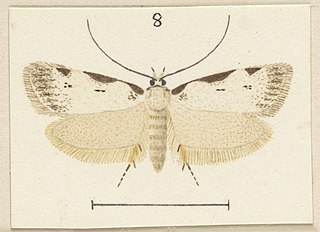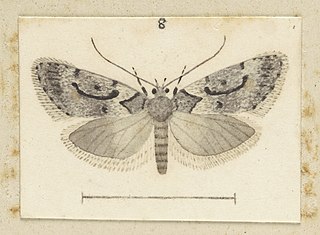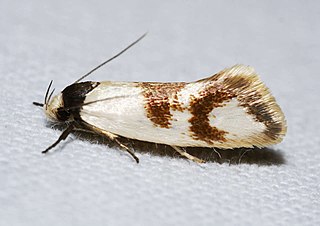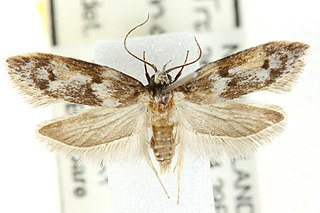
Izatha balanophora is a moth of the family Oecophoridae. It is endemic to New Zealand, where it is widespread in the North Island. Larvae live off the dead bark of kānuka. The adult moths are on the wing during December to March.

Izatha manubriata is a moth of the family Oecophoridae. It is endemic to New Zealand, where it is known from the southern South Island only.

Tingena chrysogramma is a species of moth in the family Oecophoridae. It is endemic to New Zealand and is found in the North and South Islands. The adults of this species inhabits open scrubland and are on the wing in January and February. It has been collected via light traps and beating shrubs. During sunny days this species has been observed resting on leaves and rarely flies. It is regarded as a rare species and has a possible association with Prumnopitys ferruginea.

Tingena maranta is a species of moth in the family Oecophoridae. It is endemic to New Zealand and is found in the lower South Island. Adults of this species are on the wing from October until January. This species prefers grass or low herb habitat. Unlike its close relatives it does not inhabit native forest.

Antipterna is a genus of moths of the family Oecophoridae, first described by Edward Meyrick in 1916.

Antipterna trilicella is a species of moth in the family Oecophoridae, first described by Edward Meyrick in 1885 as Ocystola trilicella. It appears to be a moth endemic to Australia and confined to the east coast, occurring in Victoria, New South Wales and Queensland.

Antipterna euanthes is a species of moth in the family Oecophoridae, first described by Edward Meyrick in 1885 as Ocystola euanthes, with the female lectotype being found in the Wirrabara Forest, South Australia. It appears to be a moth endemic to Australia and in addition to South Australia is also found in Victoria, New South Wales, and Queensland.
Antipterna acrobaphes is a species of moth in the family Oecophoridae, first described by Edward Meyrick in 1885 as Ocystola acrobaphes. The holotype was collected in Sydney, New South Wales, in January 1878.
Antipterna diclethra is a species of moth in the family Oecophoridae, first described by Edward Meyrick in 1885 as Ocystola diclethra. Lectotypes for both Ocystola diclethra and Machaeretis niphoessa were both collected in greater Sydney, New South Wales.
Antipterna glacialis is a species of moth in the family Oecophoridae, first described by Edward Meyrick in 1885 as Ocystola glacialis. The holotype was collected at Mount Lofty, South Australia.
Antipterna homoleuca is a species of moth in the family Oecophoridae, first described by Edward Meyrick in 1885 as Ocystola homoleuca. The lectotype for Ocystola homoleuca was collected at Wirrabara, South Australia, while that for Ocystola argophanes was collected in Brisbane, Queensland.
Antipterna lithophanes is a species of moth in the family Oecophoridae, first described by Edward Meyrick in 1885 as Ocystola lithophanes. The lectotype for Ocystola lithophanes was collected at Deloraine, Tasmania. Holotypes for Alfred Jefferis Turner's synonyms were collected from Queensland and New South Wales.
Antipterna assulosa is a species of moth in the family Oecophoridae, first described by Alfred Jefferis Turner in 1940 as Machaeretis assulosa. The species epithet, assulosa, derives from the Latin adjective, assulosus. The holotype for Machaeretis assulosa was collected at Sandgate in Queensland.
Antipterna diplosticta is a species of moth in the family Oecophoridae, first described by Alfred Jefferis Turner in 1944 as Ocystola diplosticta. The species epithet, diplosticta, derives from the Greek, διπλοστικτος. The male holotype for Ocystola diplosticta was collected at Gladstone in Queensland.
Antipterna homopasta is a species of moth in the family Oecophoridae, first described by Alfred Jefferis Turner in 1932 as Periallactis homopasta. The species epithet, homopasta, derives from the Greek, όμοπαστος. The male holotype for Periallactis homopasta was collected at Crows Nest in Queensland.
Antipterna spathulata is a species of moth in the family Oecophoridae, first described by Alfred Jefferis Turner in 1944 as Ocystola spathulata. The species epithet, spathulata, derives from the Latin, spathulatus ("spoon-shaped"). The male lectotype for Ocystola spathulata was collected at Waroona in Western Australia.
Antipterna tephrodes is a species of moth in the family Oecophoridae, first described by Oswald Bertram Lower in 1902 as Ocystola tephrodes. The male holotype for Ocystola tephrodes was collected at Stawell in Victoria.
Antipterna microphanes is a species of moth in the family Oecophoridae, first described by Oswald Bertram Lower in 1902 as Ocystola microphanes. The male holotype for Ocystola microphanes was collected at Stawell in Victoria.
Antipterna stichoptis is a species of moth in the family Oecophoridae, first described by Oswald Bertram Lower in 1915 as Linosticha stichoptis. The male holotype for Linosticha stichoptis was collected at Broken Hill in New South Wales, in a Casuarina.

Trachypepla importuna is a moth of the family Oecophoridae first described by Edward Meyrick in 1927. This moth is regarded as having been introduced to New Zealand and is presumed to be native to Australia. T. importuna has been collected in both the North and South Islands of New Zealand. It inhabits native scrub and adults are on the wing in January and February. The placement of this species in the genus Trachypepla is regarded as being unsatisfactory and in need of revision.







